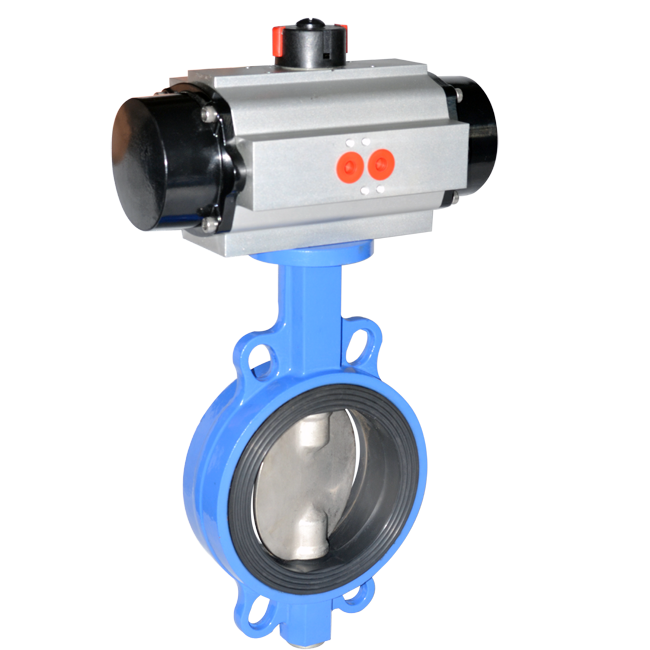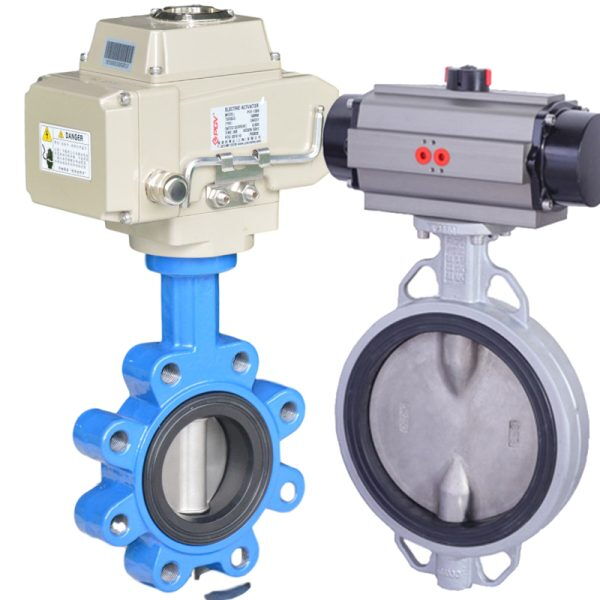
Pneumatic butterfly control valves are among the most widely used control devices in industrial automation, offering precision flow management with compact design and reliable performance. Their ability to regulate liquids, gases, and steam in diverse industrial processes makes them indispensable in sectors ranging from chemical processing and pharmaceuticals to water treatment and HVAC systems.
The fundamental principle behind a pneumatic butterfly valve is simple: a disc rotates within the valve body to control flow. However, the engineering, actuation methods, and control strategies behind these valves have evolved to meet the growing demand for efficiency, automation, and safety in modern industrial systems. This article explores the working principles, classifications, applications, installation best practices, troubleshooting techniques, and future trends of pneumatic butterfly control valves.
A pneumatic butterfly control valve is a quarter-turn valve actuated by compressed air. Unlike manual valves, pneumatic actuation allows rapid, remote, and automated operation. The valve disc rotates 90 degrees to open or close the passage, controlling the flow of fluids or gases in a pipeline.
The compact, lightweight design of butterfly valves makes them ideal for large-diameter pipelines where space is limited. Depending on the construction materials, they can handle corrosive chemicals, viscous liquids, steam, and even abrasive slurries.

High reliability: Simple design reduces mechanical failures.
Fast response: Rapid actuation enables real-time control of flow and pressure.
Fail-safe operation: Spring-return actuators ensure the valve defaults to a safe position in case of air supply failure.
Precision flow control: With analog or digital signals, the disc can modulate flow accurately.
Ease of maintenance: Fewer moving parts compared to globe or gate valves.
Versatility: Suitable for corrosive, high-temperature, or hazardous media.
The operation of a pneumatic butterfly valve is based on converting compressed air energy into mechanical rotation to move the valve disc. This process can be divided into several steps:
Control signals originate from a PLC (programmable logic controller), distributed control system (DCS), or manual operator interface. Upon receiving the signal, the pneumatic system triggers the supply of compressed air to the actuator.
The compressed air flows through tubing and solenoid or directional control valves to the actuator. Clean, dry, and regulated air is essential for reliable operation. Any contamination, moisture, or pressure fluctuation can affect actuator performance.
Pneumatic actuators are the driving force behind the valve operation. They are mainly categorized into two types:
Use compressed air to drive the actuator in both directions.
The actuator can rotate the valve disc using mechanisms like rack-and-pinion, scotch-yoke, or rotary vane designs.
Air exhaust ports allow smooth operation, and reversing air supply changes the rotation direction.
Provide high torque and rapid response, suitable for large valves and high-pressure systems.
Use compressed air to move the valve in one direction and a spring to return it to its default position.
Ensure fail-safe operation, automatically returning the valve to open or closed in case of air failure.
Ideal for safety interlocks, emergency shutdowns, and critical processes requiring default safe positions.
The actuator rotation translates directly to the butterfly disc inside the valve body. The disc’s position determines the flow:
0° (Fully Closed): The disc presses against the resilient seat, sealing the valve.
90° (Fully Open): The disc aligns parallel with the pipe axis, minimizing resistance.
Intermediate Angles: The disc partially obstructs flow for precise throttling or modulation.
Modern pneumatic butterfly valves can be equipped with positioners, limit switches, or smart sensors. These provide real-time feedback on the disc position, enabling automated systems to verify valve status, detect faults, and adjust flow with high precision.
Require air supply for both opening and closing.
Provide high torque and fast actuation, suitable for large-diameter valves.
Common in high-pressure, high-temperature, and heavy-duty industrial applications.
Use compressed air in one direction and a spring to return the valve.
Ensure fail-safe operation, critical in emergency shutdowns or safety-critical processes.
Widely used in chemical, petrochemical, and pharmaceutical industries.
Designed for simple open/close operation.
Simple control, ideal for isolation or shut-off applications.
Capable of precise flow control using analog or digital control signals.
Typically receive 4–20 mA or 0–10 V signals to adjust disc position.
Essential in automated processes where exact flow rates, pressure, or temperature must be maintained.
Valve Body: Houses the disc, stem, and seat. Materials vary from stainless steel, carbon steel, ductile iron, to specialty alloys.
Butterfly Disc: The flow control element. Materials may include stainless steel, rubber-coated metal, PTFE, or other corrosion-resistant alloys.
Stem: Connects the disc to the actuator, transmitting rotational torque.
Seat: Provides a tight seal when the valve is closed. Can be resilient (elastomeric) or metal.
Actuator: Converts pneumatic energy into mechanical motion. Can be spring-return or double-acting.
Positioner (Optional): Ensures precise control, often integrating with digital control systems.
Pneumatic butterfly valves handle corrosive liquids, acids, and solvents with resistant materials. They are widely used in mixing, dosing, and pipeline isolation.
Sanitary pneumatic butterfly valves enable precise dosing, prevent contamination, and comply with hygiene standards.
FDA-compliant butterfly valves manage water, syrups, and other liquids in production lines, ensuring both safety and flow accuracy.
These valves regulate water flow, chemical dosing, and pressure in municipal and industrial water treatment systems.
Airflow control in air handling units, chillers, and heating systems is efficiently managed with pneumatic butterfly valves.
Pneumatic butterfly valves control the flow of crude oil, natural gas, and refined products in pipelines and process systems, often under high pressure and temperature conditions.
Valve Orientation: Install according to manufacturer instructions to prevent seat deformation.
Actuator Alignment: Misalignment can cause uneven torque and accelerated wear.
Air Supply Quality: Clean, dry, and properly regulated compressed air ensures consistent actuator performance.
Routine Inspection: Check for leaks, corrosion, and wear regularly.
Lubrication: Periodically lubricate stems and actuator components if required.
Seal Maintenance: Replace worn or damaged seals promptly to maintain tight shutoff and accurate flow control.
Common issues and solutions include:
Valve Leakage: Check seat integrity and disc alignment. Replace worn seals.
Slow Actuation: Inspect actuator for air supply issues or mechanical binding.
Sticking Disc: Remove buildup or corrosion on disc and seat surfaces.
Position Feedback Errors: Calibrate positioners or replace faulty limit switches.
Air Consumption Issues: Check for leaks in pneumatic tubing or actuator.
Regular preventive maintenance ensures long-term reliability and reduces downtime in critical industrial systems.
Gate Valves: Provide tight sealing but are slower and larger than butterfly valves.
Globe Valves: Excellent throttling but require more space and effort to actuate.
Ball Valves: Good for on-off service; less suitable for fine flow control in large pipelines.
Pneumatic butterfly valves offer a balance of compact design, rapid actuation, and moderate flow control capabilities, making them ideal for automated industrial systems.
Digital Positioners and Smart Actuators: Integration with IIoT allows predictive maintenance, real-time monitoring, and data-driven control.
Advanced Materials: New alloys, coatings, and elastomers improve durability, chemical resistance, and temperature tolerance.
Energy Efficiency: Optimized actuator designs and air supply management reduce compressed air consumption.
Automation Integration: Seamless connection to PLC, SCADA, and DCS systems enables smarter process management.
Fail-Safe Enhancements: New spring-return and double-acting designs increase safety in critical operations.
A petrochemical facility implemented spring-return pneumatic butterfly valves to control corrosive acid flow. The fail-safe operation prevented environmental hazards during air supply failures, improving plant safety and regulatory compliance.
Automated regulating pneumatic butterfly valves controlled chlorine dosing and flow rates, optimizing water quality and reducing chemical waste. Position feedback allowed integration with SCADA for remote monitoring and precise flow adjustment.
Large air handling units used double-acting pneumatic butterfly valves to modulate airflow across multiple zones. Rapid response and minimal pressure drop improved energy efficiency while maintaining occupant comfort.
Pneumatic butterfly control valves are versatile, reliable, and efficient components for modern industrial automation. They combine rapid actuation, precise flow control, and fail-safe operation, making them ideal for industries ranging from chemical processing and pharmaceuticals to water treatment and HVAC.
By understanding their working principle, actuator types, control methods, maintenance requirements, and applications, industries can optimize operations, enhance safety, and improve process efficiency. With advances in digital integration, smart positioners, and high-performance materials, pneumatic butterfly valves are poised to remain a critical element in automated industrial systems for years to come.